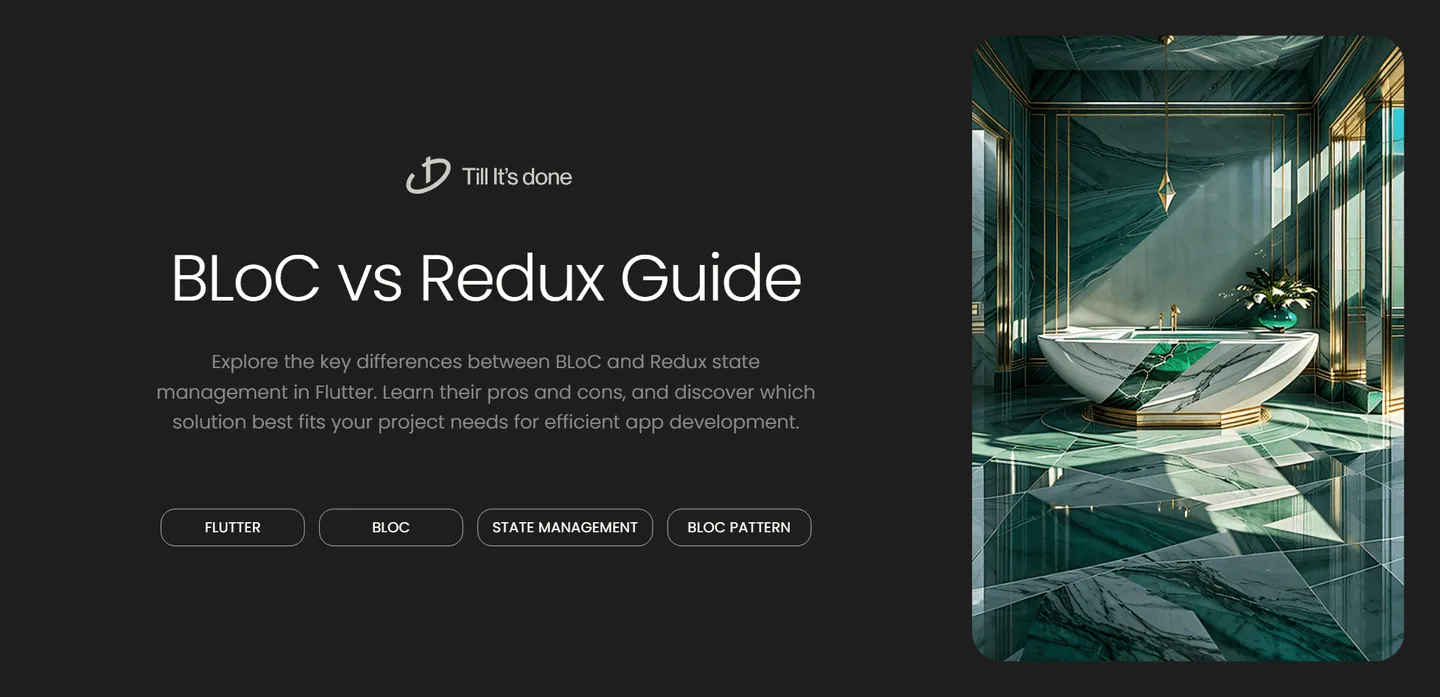- Services
- Case Studies
- Technologies
- NextJs development
- Flutter development
- NodeJs development
- ReactJs development
- About
- Contact
- Tools
- Blogs
- FAQ
BLoC vs Redux: Flutter State Management Guide
Learn their pros and cons, and discover which solution best fits your project needs for efficient app development.

BLoC vs Redux: Which State Management Solution is Better for Flutter?

When diving into Flutter development, one of the most crucial decisions you’ll face is choosing the right state management solution. Two popular contenders often come up in this discussion: BLoC (Business Logic Component) and Redux. Let’s break down these approaches and help you make an informed decision for your next project.
Understanding the Basics
Before we dive deep, let’s clarify what we’re dealing with. BLoC is Flutter’s own state management pattern that leverages streams, while Redux is a predictable state container ported from the React ecosystem. Both aim to solve the same problem but take different routes to get there.

The BLoC Pattern: Stream-Based State Management
BLoC works like a conductor in an orchestra, coordinating the flow of data through streams. It keeps your UI clean and your business logic separate, making your code more maintainable and testable.
Advantages of BLoC:
- Native to Flutter and follows Dart’s stream-based approach
- Great for handling real-time data and async operations
- Excellent separation of concerns
- Built-in support for state transitions
Challenges with BLoC:
- Steeper learning curve for developers new to reactive programming
- Can be verbose for simple state changes
- Stream management requires careful attention
Redux: Predictable State Container

Redux brings a different philosophy to the table. It maintains a single source of truth and uses pure functions (reducers) to transform state based on actions.
Advantages of Redux:
- Predictable state updates
- Powerful debugging capabilities
- Well-documented with a large community
- Time-travel debugging possibilities
Challenges with Redux:
- More boilerplate code required
- Can be overkill for smaller applications
- State updates can become complex in large applications
Making the Right Choice
The decision between BLoC and Redux often comes down to your specific needs:
Choose BLoC if:
- You’re building a Flutter-first application
- Your app deals with lots of real-time data
- You want to leverage Dart’s stream-based architecture
- You prefer a more Flutter-native solution
Choose Redux if:
- You’re migrating from a React/Redux background
- You need strict state management with time-travel debugging
- Your team is already familiar with Redux concepts
- You want a battle-tested solution with extensive documentation

Final Thoughts
Both BLoC and Redux are powerful state management solutions with their own strengths. BLoC shines in Flutter-native development and real-time applications, while Redux excels in predictability and debugging capabilities. The best choice depends on your team’s experience, project requirements, and long-term maintenance considerations.
Remember, there’s no one-size-fits-all solution. What matters most is choosing the tool that best fits your project’s needs and your team’s capabilities.
 สร้างเว็บไซต์ 1 เว็บ ต้องใช้งบเท่าไหร่? เจาะลึกทุกองค์ประกอบ website development cost อยากสร้างเว็บไซต์แต่ไม่มั่นใจในเรื่องของงบประมาณ อ่านสรุปเจาะลึกตั้งแต่ดีไซน์, ฟังก์ชัน และการดูแล พร้อมตัวอย่างงบจริงจาก Till it’s done ที่แผนชัด งบไม่บานปลายแน่นอน
สร้างเว็บไซต์ 1 เว็บ ต้องใช้งบเท่าไหร่? เจาะลึกทุกองค์ประกอบ website development cost อยากสร้างเว็บไซต์แต่ไม่มั่นใจในเรื่องของงบประมาณ อ่านสรุปเจาะลึกตั้งแต่ดีไซน์, ฟังก์ชัน และการดูแล พร้อมตัวอย่างงบจริงจาก Till it’s done ที่แผนชัด งบไม่บานปลายแน่นอน  Next.js สอน 14 ขั้นตอนเบื้องต้น: สร้างโปรเจกต์แรกใน 30 นาที เริ่มต้นกับ Next.js ใน 14 ขั้นตอนเพียงแค่ 30 นาที พร้อม SSR/SSG และ API Routes ด้วยตัวอย่างโค้ดง่าย ๆ อ่านต่อเพื่อสร้างโปรเจ็กต์แรกได้ทันทีที่นี่
Next.js สอน 14 ขั้นตอนเบื้องต้น: สร้างโปรเจกต์แรกใน 30 นาที เริ่มต้นกับ Next.js ใน 14 ขั้นตอนเพียงแค่ 30 นาที พร้อม SSR/SSG และ API Routes ด้วยตัวอย่างโค้ดง่าย ๆ อ่านต่อเพื่อสร้างโปรเจ็กต์แรกได้ทันทีที่นี่  วิธีสมัคร Apple Developer Account เพื่อนำแอปขึ้น App Store ทีละขั้นตอน อยากปล่อยแอปบน App Store ระดับโลก มาอ่านคู่มือสมัคร Apple Developer Account พร้อมเคล็ดลับ TestFlight และวิธีอัปโหลดที่ง่ายในบทความเดียวนี้ได้เลย
วิธีสมัคร Apple Developer Account เพื่อนำแอปขึ้น App Store ทีละขั้นตอน อยากปล่อยแอปบน App Store ระดับโลก มาอ่านคู่มือสมัคร Apple Developer Account พร้อมเคล็ดลับ TestFlight และวิธีอัปโหลดที่ง่ายในบทความเดียวนี้ได้เลย  TypeScript Interface คืออะไร? อธิบายพร้อมวิธีใช้และข้อแตกต่างจาก Type เรียนรู้วิธีใช้ TypeScript Interface เพื่อสร้างโครงสร้างข้อมูลที่ปลอดภัยและเข้าใจง่าย พร้อมเปรียบเทียบข้อดีข้อแตกต่างกับ Type ที่คุณต้องรู้ ถูกรวมเอาไว้ในบทความนี้แล้ว
TypeScript Interface คืออะไร? อธิบายพร้อมวิธีใช้และข้อแตกต่างจาก Type เรียนรู้วิธีใช้ TypeScript Interface เพื่อสร้างโครงสร้างข้อมูลที่ปลอดภัยและเข้าใจง่าย พร้อมเปรียบเทียบข้อดีข้อแตกต่างกับ Type ที่คุณต้องรู้ ถูกรวมเอาไว้ในบทความนี้แล้ว  Material-UI (MUI) คืออะไร อยากสร้าง UI สวยงามและเป็นมืออาชีพในเวลาอันรวดเร็วใช่ไหม มาทำความรู้จักกับ Material-UI (MUI) ที่ช่วยให้คุณพัฒนาแอปพลิเคชันบน React ได้ง่ายและดูดีในทุกอุปกรณ์
Material-UI (MUI) คืออะไร อยากสร้าง UI สวยงามและเป็นมืออาชีพในเวลาอันรวดเร็วใช่ไหม มาทำความรู้จักกับ Material-UI (MUI) ที่ช่วยให้คุณพัฒนาแอปพลิเคชันบน React ได้ง่ายและดูดีในทุกอุปกรณ์  เปรียบเทียบ 3 วิธีติดตั้ง install node js บน Ubuntu: NVM vs NodeSource vs Official Repo แบบไหนดีที่สุด? เรียนรู้วิธีติดตั้ง Node.js บน Ubuntu ด้วย NVM, NodeSource หรือ Official Repo เลือกวิธีที่เหมาะกับความต้องการของคุณ พร้อมเปรียบเทียบ เพื่อการพัฒนาที่มีประสิทธิภาพ!
เปรียบเทียบ 3 วิธีติดตั้ง install node js บน Ubuntu: NVM vs NodeSource vs Official Repo แบบไหนดีที่สุด? เรียนรู้วิธีติดตั้ง Node.js บน Ubuntu ด้วย NVM, NodeSource หรือ Official Repo เลือกวิธีที่เหมาะกับความต้องการของคุณ พร้อมเปรียบเทียบ เพื่อการพัฒนาที่มีประสิทธิภาพ! Talk with CEO
We'll be right here with you every step of the way.
We'll be here, prepared to commence this promising collaboration.
Whether you're curious about features, warranties, or shopping policies, we provide comprehensive answers to assist you.


